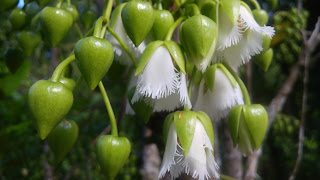Critically endangered Elaeocarpus bojeri (Bois Dentelle) in flower on Le Pouce Mountain. The site is heavily invaded with the invasive alien species "Goyave de Chine" (Psidium cattleianum) and the Biodiversity Unit of the Forestry Service have no other option but to carry out cleaning operations at regular intervals in this nature reserve.
 |
| Eleaocarpus bojerii Photo: Reza Ramjaun |
Le Pouce Mountain is visited by many locals and vistors from abroad on a daily basis and
 |
| Area heavily invaded with "Goyave de Chine Photo: Reza Ramjaun |
 |
| Pure white blooms of Bois Dentelle Photo: Reza Ramjaun |
Le Pouce Nature Reserve harbours several critically endangered species and I am thinking of writing a post on the "treasures" found in this Nature Reserve. While we are it, an eminent visitor, Charles Darwin made an ascent of the 812m of Le Pouce Mountain on 02 May 1836, on his visit to Mauritius during his famous voyage around the world. The view offered to him from Le Pouce Mountain is recorded in his journal.






